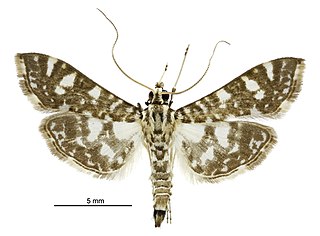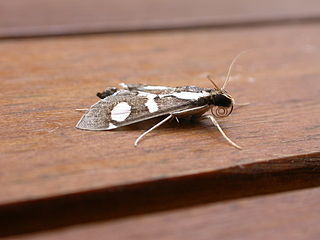
Glyphodes is a genus of moths of the family Crambidae described by Achille Guenée in 1854.
Tessema sensilis is a little-known moth species, the only member of genus Tessema. It belongs to the grass moth family (Crambidae), and therein to the large subfamily Spilomelinae; at the time of its description, these were still included in subfamily Pyraustinae and the entire Crambidae was then merged with the snout moths. While its detailed relationships are undetermined, it may be a close relative of Herpetogramma and/or Pilocrocis.

Diaphania indica, the cucumber moth or cotton caterpillar, is a widespread but mainly Old World moth species. It belongs to the grass moth family, and therein to the large subfamily Spilomelinae. This moth occurs in many tropical and subtropical regions outside the Americas, though it is native to southern Asia; it is occasionally a significant pest of cucurbits and some other plants.
Glyphodes cyanomichla, the blue glyphodes moth, is a moth of the family Crambidae. It is endemic to the Hawaiian islands of Kauai, Oahu, Molokai and Hawaii.

Glyphodes bivitralis is a moth of the family Crambidae described by Achille Guenée in 1854. It is native to south-east Asia, including Hong Kong, India, Japan, Taiwan and Thailand. It is also found in Queensland, Hawaii and Maldives.
Glyphodes perelegans is a moth of the family Crambidae described by George Hampson in 1898. It is native to South America, where it is found in the Andes Mountains of Venezuela, Colombia, and Ecuador. It has been introduced to Hawaii to control banana poka.

Chabulina onychinalis, also known as the swan flower plant moth and until recently called Glyphodes onychinalis, is a moth of the family Crambidae. It is native to the Afro-Asian Region, including India, Sri Lanka, Hong Kong, Thailand, Indonesia, Japan, Australia and New Zealand, and has been recorded in California since 2000.

Glyphodes negatalis, the karanj defoliator, is a moth of the family Crambidae. The species was first described by Francis Walker in 1859. It has a wide range in the tropics, including South Africa, The Gambia, Mali, India, Sri Lanka, Hong Kong, Japan, and eastern Australia.

Glyphodes sibillalis, the mulberry leaftier moth, is a moth of the family Crambidae. It is found in the southern United States, Central and South America and the West Indies.

Glyphodes bicolor is a species of moth of the family Crambidae described by William John Swainson in 1821. It is widely distributed in the Old World tropics, including South Africa, China, Thailand, India, New Guinea and Australia.

Glyphodes boseae is a moth of the family Crambidae. It was described by Max Saalmüller in 1880 and it is found in Madagascar.
Glyphodes bitriangulalis is a moth of the family Crambidae described by Max Gaede in 1917. It is found in South Africa (Gauteng), Zimbabwe, and Mali.
Glyphodes paramicalis is a moth of the family Crambidae described by George Hamilton Kenrick in 1917. It is found in Madagascar.

Glyphodes pulverulentalis is a moth of the family Crambidae. It was first described by George Hampson in 1896.
Bradina itysalis is a moth species in the family Crambidae. It was described by Pierre Viette in 1957. It is found on Príncipe island, São Tomé and Príncipe.

Glyphodes canthusalis is a moth in the family Crambidae. It was described by Francis Walker in 1859. It is found in Taiwan, mainland India, Sri Lanka and on the Andaman Islands, Vietnam, Indonesia and Australia.

Glyphodes pyloalis, the lesser mulberry snout moth, lesser mulberry pyralid or beautiful glyphodes moth, is a moth in the family Crambidae. It was described by Francis Walker in 1859. It is found in Iran, China, Japan, India, Indonesia (Sumatra), Sri Lanka, Taiwan, the Democratic Republic of the Congo, Equatorial Guinea, Mozambique and North America, where it has been recorded from Florida, Maryland, North Carolina, South Carolina and Virginia.
Glyphodes margaritaria is a moth in the family Crambidae. It was described by Carl Alexander Clerck in 1764. It is found in Indonesia, New Guinea and northern Australia, including Queensland.
Glyphodes flavizonalis is a moth in the family Crambidae. It was described by George Hampson in 1898. It is found in Australia, where it has been recorded from Queensland.










